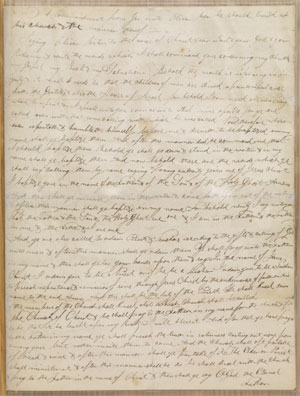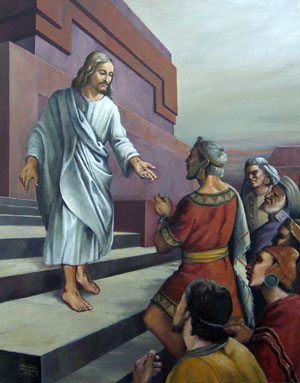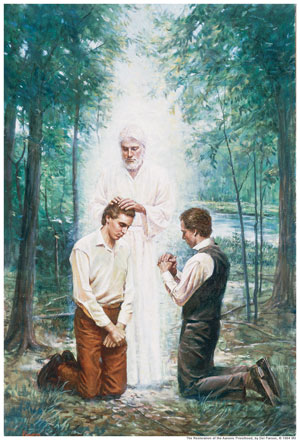
The Know
After reading the account in 3 Nephi of Jesus giving his disciples “power to baptize” (3 Nephi 11:21–22), Joseph Smith and Oliver Cowdery sought to know how they could receive that authority for themselves. In May 1829, they knelt by the Susquehanna River and in answer to their prayers, John the Baptist appeared and conferred upon them the Aaronic Priesthood.1 Not long afterward, the Melchizedek Priesthood was also restored.
Following the official organization of the Church on April 6, 1830, the Lord began to gradually reveal guidelines regarding the specific offices of the priesthood. He explained the roles of apostles, elders, priests, teachers, and deacons in April 1830 (Doctrine and Covenants 20:38–60). He then explained the role of bishops in February 1831 (Doctrine and Covenants 41:9–10), high priests in June 1831 (Doctrine and Covenants 52, heading), patriarchs in December 1833,2 and Seventies in 1835 (Doctrine and Covenants 107:23–24).
A June 1829 document on church administration, entitled “Articles of the Church of Christ,” written by Oliver Cowdery, borrows heavily from the Book of Mormon. According to historian Scott Faulring, “more than half of Cowdery’s Articles are either direct quotations or paraphrases with slight deviations from the Book of Mormon.”3 The subsequent revelation now found in Doctrine and Covenants 20 likewise draws heavily on the Book of Mormon. This includes details on priesthood offices and administration found in Moroni 3 and 4.4
Early on in the Book of Mormon, there are references to priesthood callings and the performance of duties. Nephi “did consecrate Jacob and Joseph, that they should be priests and teachers over the land of my people” (2 Nephi 5:26; Jacob 1:18). Jarom also mentioned the ministry of prophets, priests, and teachers (Jarom 1:1). Examples of such priesthood callings continue throughout Book of Mormon history.5
Perhaps the most significant description of priesthood orders and offices in the Book of Mormon is in Alma 13, which may have informed Joseph Smith's understanding of the origins of the term Melchizedek Priesthood. Alma explained that priests were called and ordained to “the high priesthood according to the holy order of God” (Alma 13:6, 18) or God’s “holy order, which was after the order of his Son” (Alma 13:1). Although Alma does not call this “holy order” the Melchizedek Priesthood, as it is called today, he does explain that Melchizedek “was also a high priest after this same order” of the “high priesthood” (Alma 13:14).
Compare Alma’s explanation to the reasons given for the name “Melchizedek Priesthood” recorded in Doctrine and Covenants 107:2–3:
Why the first is called the Melchizedek Priesthood is because Melchizedek was such a great high priest. Before his day it was called the Holy Priesthood, after the Order of the Son of God.
Although the Book of Mormon authors do not often make reference to the name of the God-given “authority” (Mosiah 23:17) that allowed them to act in their priesthood offices, it is clear that they held the Melchizedek Priesthood.6
When Christ appeared to the Book of Mormon peoples after His Resurrection, he organized the priesthood system among them following the pattern He had established in the New Testament Church. Joseph Smith declared that when the “Savior made his appearance upon this continent after his resurrection … he planted the gospel here in all its fullness, and richness, and power, and blessings; that they had apostles, prophets, pastors, teachers and evangelists; the same order, the same priesthood, the same ordinances, gifts, powers, and blessings, as were enjoyed on the Eastern Continent.”7
Joseph Fielding McConkie argued that this priesthood organization “evidently included the Aaronic or lesser priesthood.”8 Similarly, President Joseph Fielding Smith commented that Jesus Christ “gave the Nephites all the authority of the priesthood which we exercise today. Therefore, we are justified in the belief that not only was the fullness of the Melchizedek Priesthood conferred, but also the Aaronic, just as we have it in the Church today; … We may be assured that in the days of Moroni the Nephites did ordain teachers and priests in the Aaronic Priesthood.”9
The Why
As can be seen from the examples of Joseph Smith and Oliver Cowdery, early Church leaders frequently looked to the Book of Mormon as a guide, given by God, for how the priesthood of Christ’s church should be organized. When the early saints strayed too far from its teachings, the Lord admonished them to “repent and remember the new covenant, even the Book of Mormon and the former commandments which I have given them, not only to say, but to do according to that which I have written” (Doctrine and Covenants 84:57).
The Book of Mormon provided the early saints with many further examples of the priesthood in action, beyond what was available in the Bible. It demonstrated the division between orders of the priesthood and some of its various offices. Furthermore, the Book of Mormon authors demonstrated how priesthood authority was inseparably associated with the establishment of Christ’s church, as can be seen in the examples of Nephi and his temple (2 Nephi 5), Alma at the waters of Mormon (Mosiah 18), and Jesus Christ himself in the land of Bountiful (3 Nephi 11–12). Readers today can likewise benefit from these examples of righteous priesthood holders in the Book of Mormon as they seek to understand the role of the priesthood in the Church today.
Further Reading
Book of Mormon Central, “What Does the Book of Mormon Teach about the Priesthood? (Mosiah 23:17),” KnoWhy 289 (March 20, 2017).
Scott H. Faulring, “The Book of Mormon: A Blueprint for Organizing the Church,” Journal of Book of Mormon Studies 7, no. 1 (1998): 66–69.
John W. Welch, “From Presence to Practice: Jesus, the Sacrament Prayers, the Priesthood, and Church Discipline in 3 Nephi 18 and Moroni 2–6,” Journal of Book of Mormon Studies 5, no. 1 (1996): 120–129.
Rodney Turner, “The Three Nephite Churches of Christ,” in The Keystone Scripture, ed. Paul R. Cheesman, Book of Mormon Symposium Series, Volume 1 (Provo, UT: Religious Studies Center, Brigham Young University, 1988), 100–126.
- 1. See Joseph F. Darowski and James Goldberg, “Restoring the Ancient Order (D&C 102, 107),” Revelations in Context, October 3, 2013, online at history.lds.org. See also Doctrine and Covenants 13; Book of Mormon Central, “Why Did Joseph and Oliver Seek Authority to Baptize? (3 Nephi 11:24–25),” KnoWhy 279 (February 4, 2017).
- 2. Joseph Smith Jr., Teachings of the Prophet Joseph Smith, compiled by Joseph Fielding Smith (Salt Lake City, UT: Deseret Book, 1976), 38–39.
- 3. Scott H. Faulring, “The Book of Mormon: A Blueprint for Organizing the Church,” Journal of Book of Mormon Studies 7, no. 1 (1998): 63.
- 4. See Book of Mormon Central, “Why Did the Lord Quote the Book of Mormon When Reestablishing the Church? (3 Nephi 11:24),” KnoWhy 282 (March 3, 2017); Scott H. Faulring, “An Examination of the 1829 ‘Articles of the Church of Christ’ in Relation to Section 20 of the Doctrine and Covenants,” BYU Studies 43, no. 4 (2004): 64; John W. Welch, “The Book of Mormon as the Keystone of Church Administration,” Religious Educator 12, no. 2 (2011): 90.
- 5. See, for example, Mosiah 6:3; 18:18.
- 6. See Rodney Turner, “The Three Nephite Churches of Christ,” in The Book of Mormon: The Keystone Scripture, ed. Paul R. Cheesman (Provo, UT: Religious Studies Center, Brigham Young University, 1988), 91–99.
- 7. “History, 1838–1856, volume C-1 [2 November 1838–31 July 1842],” p. 1282, The Joseph Smith Papers, accessed May 4, 2017.
- 8. Joseph Fielding McConkie, “Priesthood among the Nephites,” Book of Mormon Reference Companion, ed. Dennis L. Largey (Salt Lake City, UT: Deseret Book, 2003), 656.
- 9. Joseph Fielding Smith, Answers to Gospel Questions, ed. Joseph Fielding Smith Jr., 5 vols. (Salt Lake City, UT: Deseret Book, 1957–1966), 1:126. There are, naturally, differences between the offices and functions of the priesthood in the Nephite dispensation and the current one. For more on this, see Book of Mormon Central, “What Does the Book of Mormon Teach about the Priesthood? (Mosiah 23:17),” KnoWhy 289 (March 20, 2017).
Continue reading at the original source →






